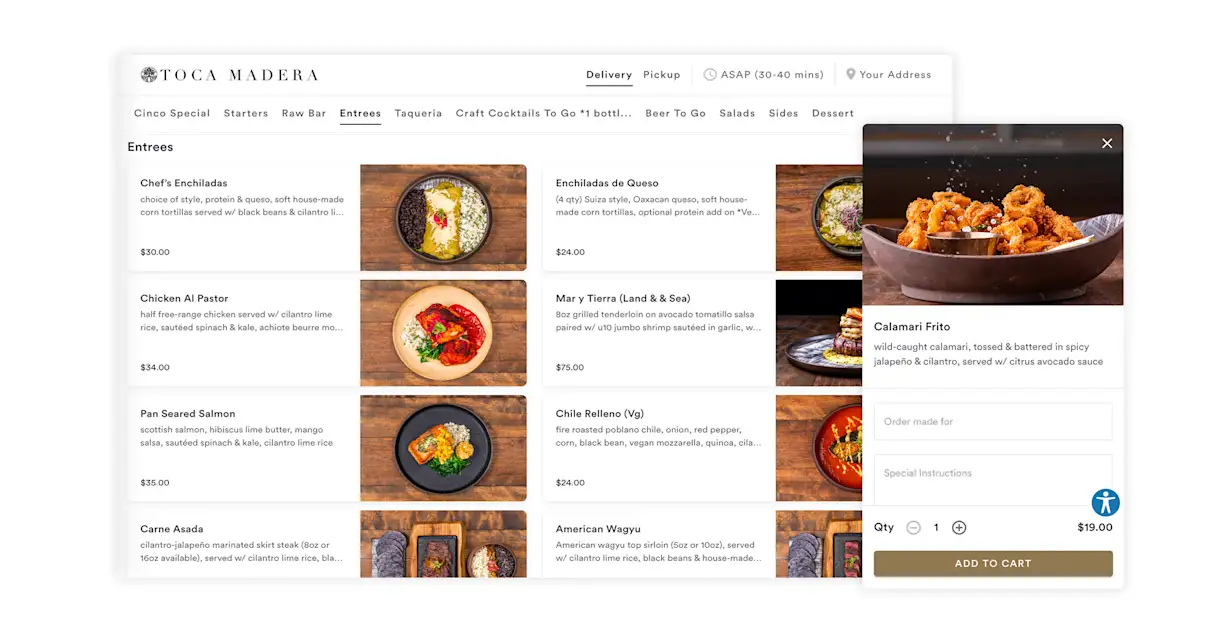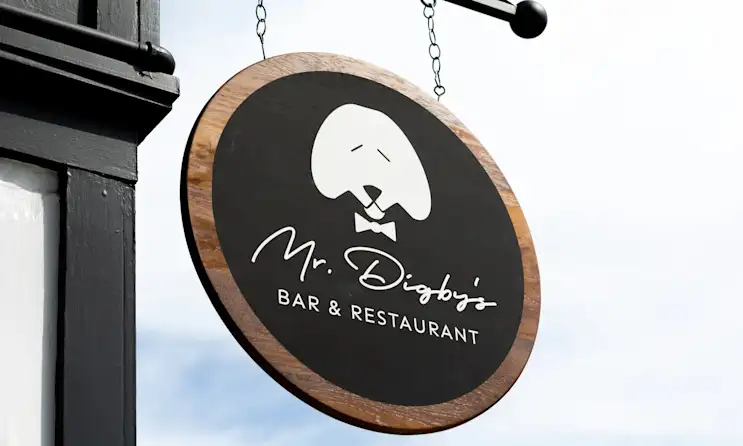New Openings
How to Open a Restaurant + Free Business Plan Template
A step-by-step guide to planning, financing, staffing, stocking and marketing a new restaurant for its debut.
Opening a restaurant? Good! As the restaurant industry grows and demand for both on-premise dining and takeout increases, there’s a need for new eateries: ones that cook up signature dishes, boast a loyal group of employees and patrons, establish a special place in their communities and, naturally, make money.
Of course, this is easier said than done (especially that last part). A restaurant must take a series of steps before it can open its doors to the public. Luckily, there are resources to help aspiring restaurateurs make their dreams come true.
Read below for a step-by-step guide to planning, financing, staffing, stocking and marketing a new restaurant for its debut.
Step 1: Write a Restaurant Business Plan
A business plan is like an instruction manual. It documents the who, what, where, why and how of the restaurant's strategy.
This is a crucial first step for restaurant owners, because it forces them to get serious and answer important questions about their business. It is also a crucial tool for the next section of this guide — securing funding — because it convinces investors and lenders that the restaurant has a reasonable path to success.
Elements of a Restaurant Business Plan
Executive Summary: A 1-2 page overview of the full business plan. This should summarize all of the plan's most important information. The sections that follow the summary reinforce your key points in more detail, but the summary itself should be clear, concise and convincing.
Leadership Team: An introduction to the people who will run the restaurant, including short biographies. Some people who might be worth including here are the restaurant’s owners, any known investors, franchise representatives, managers and back-of-house leaders such as the head chef.
Business Overview: An introduction to the restaurant’s concept. This section should paint the picture of what potential guests can expect when they walk through the door, pull up to the drive-thru or place an order on the restaurant’s website. The restaurant’s mission statement, menu overview and service style should all be summarized.
Industry & Market Analysis: An overview of research on the restaurant's industry, location and audience. The more detail provided in this section, the more valid the conclusions reached in the financials section will appear. Topics may include the restaurant's target customer profile and local competitive landscape.
Marketing Strategy: A high-level overview of how the restaurant will reach its target market. Its overall brand positioning, as well as priority marketing channels (social media, public relations, website marketing, etc.), should all be explained here. A more thorough marketing plan should come at a later date (see Step 6 below).
Operating Model: A description of the restaurant's logistics. This assures readers that the pieces are in place to function efficiently — all while retaining staff, keeping the restaurant safe and making profit. The restaurant’s service model, staffing & hiring protocols and deployment of restaurant technology should be covered here in detail.
Financial Overview & Projections: An analysis of how profitable the restaurant will be and why. At the end of the day, this is what investors want to know. A thorough sales forecast, projected profit & loss statement and break-even analysis must be included, alongside supporting tables and documentation. This section is what all previous sections should build to.
Creating a Restaurant Business Plan
A restaurant’s business plan needs to show serious thought and credibility. The information itself does the heavy lifting, but design and presentation matter. Here's a free, interactive document template that includes the sections above. If you prefer a slideshow to a document, see here for design inspiration.

RESOURCE
Restaurant Business Plan Template
Download the Free Restaurant Business Plan Template from BentoBox
Step 2: Source Restaurant Financing
The average cost of opening a restaurant is around $275,000 for a leased building and $425,000 for an owned one — and that's before accounting for franchising and consulting fees, which your restaurant may also require. The process of securing funds for those costs is an important step for first-time restaurateurs, since it’s nearly impossible to get them without a sound business plan and a thorough understanding of the foodservice industry.In short, the hunt for funding prepares entrepreneurs to become restaurateurs.
Common Sources of Restaurant Funding
Small Business Administration Loan: The Small Business Administration (SBA) guarantees a certain percent of its loans in the event a borrower can't repay it. If going through one of the SBA’s preferred lenders, the process for loan approval can be handled within the institution — which can expedite the process of procuring capital by weeks. There are several SBA loan options, but the most common one for restaurants is the SBA 7(a) loan. This loan can only be used for certain expenses, but this fortunately includes most major expenditures like restaurant equipment and real estate.
Merchant Cash Advance: Companies that provide merchant cash advances lend a fixed amount of capital in exchange for a larger future repayment. For example, if a restaurant receives a $50,000 advance at a 10% markup, the creditor would be owed $55,000. Merchant cash advances are a straightforward and relatively unrestricted source of restaurant funding. They are especially popular with existing restaurants that do a lot of their business via credit card transactions.
Restaurant Investors: Rather than the fixed repayment approach of cash advances, venture capital firms or individual investors (aka “angel investors”) typically fund restaurants by buying a percentage of ownership at an agreed valuation. For example, if the restaurant needs $100,000 in funding and an investor provides that in exchange for 20% of the business, that investor agrees to value the restaurant at $500,000. Although this requires ongoing repayment, investors are incentivized to help the business grow — which can be vital if they have the right knowledge and experience.
Crowdfunding: Using sites like Kickstarter and Wefunder, restaurants can recruit the public to fund their business. With Kickstarter, entrepreneurs set a monetary goal and solicit donations by offering a series of gifts, along with potential reimbursements. Wefunder is equity crowdfunding, so investors are rewarded through a payback structure (often a revenue or profit share, or a simple loan agreement). Crowdfunding can be hard to get off the ground, but when it works it also doubles as a marketing tactic, since it builds an audience of excited future patrons.
Friends and Family: If all else fails, hopeful restaurant owners can reach out to friends, family and even former restaurant coworkers. Family-owned restaurants are no rarity, and for good reason: the partner is invested not only in the success of the business, but also the business owner. However, mixing business relationships with personal ones can be a recipe for disaster. If the business fails, it could damage personal relationships and create a rift between the entrepreneur and anyone who invested in the restaurant. Consider this an option, but proceed with caution.
Tips for Meeting With Lenders and Investors
Have a finished business plan. As mentioned earlier, the restaurant business plan is the most crucial document for opening a new restaurant. Investors — whether friends or strangers — want to know that the entrepreneur has considered the path to success from every angle. The business plan is where they demonstrate that. No serious investor will fund your restaurant without reading it closely.
Practice the pitch. Before an investor even reads your business plan, you need to convince them it's worth their time. This is where the pitch comes in. The pitch is a 45-90 second overview of the business venture; essentially, it is your answer when someone says, "tell me about the restaurant." Business owners need a succinct, compelling, enthusiastic response to that prompt. Practice your pitch with people you trust, listen to their feedback, then rehearse, rehearse, rehearse until it's perfect.
Prepare for common questions. How will you stand out in an already crowded market? When will I see a return on my investment? How did you arrive at that estimate? If your answer to any of those questions is, "I'm not sure," you're unlikely to secure meaningful funding. Anticipate common questions and come prepared with answers. It suggests you've done your homework, and that is the type of person investors and lenders want to fund.
Step 3: Secure Restaurant Permits
Due to strict regulation, restaurants might require more than a dozen licenses and permits to legally operate. Without the proper permits, restaurants could be forced to close or ruin their reputations, while owners can face fines or even criminal charges.The section below highlights ten of the most common permits and licenses a restaurant business may need. Some regions don't have federal providers for these permits, so the best way to find each permit is by searching "[name of permit]" + "[restaurant location]" on Google. To be extra safe, you can also consult with counsel or local legislature to ensure you obtain the correct permits and licenses.
10 Important Restaurant Permits & Licenses
Business License: The business license is the most basic and mandatory license for a restaurant business. It’s a formal acknowledgment of the restaurant by the local government. Typically, the price of a business license is around $50, but the cost structure does vary.
Food Service License: A food service license (or in some places, a food service permit) is exactly what it sounds like. A restaurant needs one in order to legally sell and serve food as a business. Food service permits are earned after a health inspector approves the restaurant’s safety. Provided by the local government (typically the local department of health), a food service permit tends to cost a few hundred dollars.
Employee Health Permit: Also called a food handler’s permit, this document is obtained by restaurant employees who handle, store and prepare food. Employees must demonstrate their understanding of food safety principles to obtain this permit — usually by taking a course and an exam through a facilitator like ServSafe. Costs and requirements for these permits vary based on the restaurant’s location.
Seller's Permit: Also called a sales tax permit, a seller’s permit allows the business to collect sales tax in the state in which it operates. Most states do not charge for a sales tax permit, but others do — and some even require a security deposit in case the restaurant closes while still owing taxes. Check requirements and fees for each state.
Resale Permit: A resale permit allows restaurants to purchase nontaxable goods at wholesale, which will then be resold in the restaurant. With this permit, restaurants avoid double tax and only pay tax on what is purchased from the business. This keeps food costs low by not requiring sales tax on inventory. Like the seller’s permit, this permit is only needed if the restaurant's state has a sales tax.
Liquor License: Liquor licenses are mandatory for restaurants that plan to sell alcohol, but it's important to know the different types. If you want to offer a full bar (including hard alcohol), you need either a tavern or restaurant liquor license. If you don't plan to offer hard alcohol, you can manage with a beer and wine liquor license. Liquor licenses take a notoriously long time to obtain, so reach out to your state’s Alcohol Beverage Control commission as soon as possible.
Certificate of Occupancy: A certificate of occupancy ensures a restaurant’s building is safe to enter and operate a business in. Obtaining this permit requires passing an inspection from the local zoning department, which certifies the building is up to code in terms of fire exits, wiring and other structural concerns. Luckily, certificate of occupancy costs are generally low.
Sign Permit: A quickly forgotten restaurant permit, the sign permit allows a restaurant to display outdoor signage. Applying for a sign permit may require mockups of the design, size dimensions and details on lighting and wiring needed to illuminate the sign. Sign permits are issued in the city or town in which the restaurant operates and start at around $100.
Dumpster Placement Permit: Many restaurants utilize their own dumpster, and doing so may require a dumpster permit. The necessity for restaurant dumpster placement permits varies by location, so it’s best to look up whether or not the city in which the restaurant operates requires this permit.
Valet Parking Permit: More upscale restaurants — particularly in cities — can appeal to a wider crowd by offering valet parking, which too requires a permit. Applying for a valet parking permit will usually require a detailed overview of the valet parking route and location. Like the dumpster placement permit, the need and price for a valet parking permit varies by location.
Important Non-Permits to Apply For
Employee Identification Number: An employer identification number (EIN) isn’t technically a restaurant license, but it’s necessary for restaurants to get one. An EIN provides a restaurant business with a federal tax ID, making it legal to hire and pay employees. An EIN may also be required from the state in which the restaurant does business.
Trademark: To avoid worrying about a competitor ripping off your restaurant’s brand, consider applying for a trademark. While not required, a trademark gives the original restaurant the advantage in the event the business’s brand is infringed upon. On the flip side, you should also search the existing trademark database to ensure your restaurant’s name doesn't infringe on another business.
Step 4: Build Your Restaurant's Menu
According to a survey by Harris Poll, 85% of Americans cite the quality of food as a key reason for choosing a restaurant, while 69% said the same about the price of food. This means that the type, value and quality of a menu is ultimately what drives most diners through your doors.
When opening a restaurant, the process of creating a menu can differ drastically. Franchisees might have little-to-no say in a menu, which could be dictated by corporate offices and franchisors. However, for independent restaurant owners opening up a new location, endless work goes into choosing food vendors, selecting menu items, designing dining room menus, promoting the menu online and adjusting a menu for profitability over time.
How to Create a Restaurant Menu From Scratch
Hone in on the restaurant concept. To start, a restaurant should focus on doing a few things extremely well. For example, a new pizzeria should focus most of its effort on sourcing high-quality pizza ingredients, creating unique pizza recipes and securing necessary kitchen equipment to cook perfect pizzas. From there, it can start to focus on supplements (additional things to offer) and tradeoffs (things it won't offer). For example, the pizzeria might supplement its pizzas with sandwiches and pasta dishes, but decide not to offer signature cocktails or brunch. Remember that you can always add new supplements over time. However, the fastest way to earn an audience is by doing a few things impeccably.
Break down the menu by section. Once the restaurant knows what it will be serving, it can categorize different dishes into sections. For example, the pizzeria above could break its menu out by dish type (pizzas, pastas and sandwiches). However, it could also lump different dish types into lunch and dinner sections, or it could turn dish types into sub-sections such as "red pizzas" and "white pizzas." This decision should be largely based on helping diners navigate your menu, which means it should be tailored to the dishes you plan to serve. A well-organized menu also makes choosing ingredients, managing inventory and eventually reporting on food sales significantly easier.
Consider food allergies & restrictions. While focusing on primary menu items is key, you likely don't want to exclude anyone. Guests may be pescatarian, vegetarian, paleo, keto or suffer from food allergies such as Celiac disease (an allergy to gluten). If your restaurant doesn't have options for common food restrictions, you're inviting those guests to dine elsewhere — which is especially costly if they're part of large groups who otherwise love your menu. Not every restaurant can cater to every dietary restriction, but with a good understanding of your market and target audience, you can decide which ones to prioritize.
Set price points. Pricing a restaurant menu is tricky. Prices can’t be so high they scare away patrons, but also can’t be so low they harm profitability. As a rule of thumb, food cost tends to be about 25-30% of the menu price — though certain items like pastas and desserts often have higher markups. With a new restaurant, operators should reach out to multiple food vendors to see who is willing to offer the best deals for each menu item. Securing the best ingredients at the most reasonable price is the best way to maximize profitability. No menu pricing strategy is good enough to overcome a bad deal on ingredients.
Routinely revisit menu options. Every 6-12 months, restaurants should analyze every item on their menu for popularity and profitability. After an analysis, the restaurant’s most popular and profitable menu items should be made more prominent on the menu, while the least popular and profitable might need to be removed for a stronger alternative. This is a key component of menu engineering: the process of carefully and deliberately designing a menu for maximum profitability.
Menu Design Considerations
Print Menu Design: Restaurants employ several psychological hacks to draw attention to their most profitable items, and most of them revolve around design. Placing key items at the top of the menu, putting them in a shaded box with bolded font or providing a dedicated section on the menu for them are examples of ways to accomplish this. In addition to drawing attention to key items, a restaurant's menu should have eye-catching visuals and match the brand's identity.
Online Menu Design: Many restaurants upload a PDF of their print menu to their website, but this is a mistake. Text-based menus are important for SEO rankings, which brings high-value traffic to the restaurant's website. It can be harder to make text-based menus look good, but restaurant website builders like BentoBox come equipped with clickable tabs for each section, which creates a strong user experience. Houston restaurant Rosalie is a perfect example.
Menu Descriptions: Beyond design, well-worded restaurant menu descriptions can be a strong selling point. The menu’s phrasing and word choice should paint a clear picture of what guests can expect. On-premises, this reduces how many questions guests ask servers, which helps them turn tables faster. Off-premises, where guests don't have the luxury of servers, this reduces confusion, eliminates mix-ups and increases diner confidence.
Online Ordering: Online ordering menus need to be designed for digital conversion. This means they should follow the playbook and best practices of e-commerce design: organized navigation; mobile optimization; heavy use of thumbnail images; and clickable menu items that expand for customization. BentoBox online ordering has a 98% checkout rate on cart additions, which makes sense when you see how customers like Lost Larson and Toca Madera put it to use.

Step 5: Hire Restaurant Staff
The restaurant industry workforce is enormous but also volatile. Smart restaurateurs proactively source and hire candidates who are dependable, experienced and align with their restaurant's culture. The process of training, retaining and growing great employees starts with finding the right people.
How to Hire Restaurant Workers
Write a Job Description: To ensure the candidate and hiring manager are on the same page, a job description needs to be clear and accurate. If it's not, the employee will likely leave soon after joining, which sets the restaurant back even further. The description should also pitch the value of the opportunity to the candidate. In fact, hospitality job seekers say that career growth is the most important element of a job description.
Share the Job Posting: The first place to post job descriptions are industry job boards like Poached, Restaurant Careers and RestaurantZone. Restaurants should also list job descriptions on their websites, as long as they have the technology to capture applications on the spot (BentoBox customer Los Tacos No. 1 is a great example). Once a job is posted on their website, restaurants can share it from their social media handles and encourage referrals with an employee referral program.
Interview Applicants: The interview is a mutually beneficial test for both the applicant and the hiring manager. The candidate needs to make their skills, capabilities and work ethic apparent, while the hirer needs to sell them on accepting a potential offer. In addition to assessing hard skills, interviewers should ask open-ended questions that highlight a candidate's thought process — for example, "tell me about a time you made a mistake at work and how you reacted."
Make a Competitive Offer: Once the ideal applicant is selected, the hiring manager should follow up with an offer letter and a deadline for accepting the job. The offer letter should include details on salary and benefits. Depending on how much funding you've secured, you may not be able to negotiate beyond your initial salary. However, it helps to know that average hourly wages hit all-time highs for restaurant workers in November 2021, checking in at $18.40 per hour.
Tips to Make Limited Staff More Efficient
Cross-Train Employees: Cross-training employees means equipping them to handle tasks outside their core responsibilities. For example, cashiers at a pizzeria might be expected to cut pizzas when they come out of the oven or clean tables during downtime. This has always been a part of restaurant culture, but recent staffing shortages have made it essential rather than "nice to have." Cross-training allows limited staff to cover more shifts when people call out or handle gaps in hiring.
Prioritize Staff Retention: The longer an employee works for your restaurant, the more capable they are of keeping the ship afloat with limited help. Restaurants need to prioritize workplace culture, make staff feel valued and earn enough trust to keep them from leaving. The estimated cost of turnover is thousands of dollars per employee, so in addition to making limited staff more efficient, this also clearly impacts the bottom line.
Automate Manual Tasks: One way restaurants can improve workplace culture is by automating manual administrative tasks. This eliminates daily headaches and frees up more time for workers to do what they do best: prepare food and provide hospitality. For example, restaurants can integrate their online ordering technology with their point-of-sale (POS) system, eliminating the need for staff to manually communicate direct online orders to the kitchen.

RESOURCE
Restaurant Job Description Templates
Hire faster with 33 templates for front-of-house, back-of-house and specialized restaurant job postings.
Step 6: Market Your Restaurant
For new restaurants, it can take months or even years to build up a group of regulars who come in every week or two. Even after that, restaurants need to keep their patrons engaged while simultaneously appealing to even more new customers.This is where the restaurant’s marketing comes in. In addition to a branding and positioning strategy, restaurants engage in campaigns such as events and promotions, which they communicate to customers through channels such as websites and social media. All of these ideas are summarized in a restaurant marketing plan.
Elements of a Restaurant Marketing Plan
Branding & Positioning: A detailed overview of how the restaurant aims to be perceived by potential customers. This section should provide an overview of the restaurant’s target audience (its size, demographics, challenges, etc.) and how it plans to appeal to people with those attributes. This includes specific elements such as the logo, brand colors, tagline and tone of voice. The more those elements connect with the attributes of the audience, the more successful they will be.
Online Marketing Strategy: An outline of digital activities and channels the restaurant will use to reach customers. The most important digital channel is the restaurant's website, which should be optimized with search engine optimization (SEO) tools and connect to the restaurant's Google My Business profile. Other important digital channels include organic social media, paid social media, email, loyalty programs and reviews. See the section below for more details on each.
Traditional Marketing Strategy: An outline of non-digital activities and channels the restaurant will use to reach customers. This might include direct mail, community engagement, out-of-home (OOH) ads like billboards or traditional media ads in newspapers, magazines, radio or TV. Any other engagement strategies that take place offline — like handing out loyalty punch cards or hosting ticketed events — should also be included here.
Timeline & Roadmap: A breakdown of when you plan to begin each marketing initiative. As a new restaurant, you are unlikely to launch all of the channels from your marketing strategy on Day 1. The timeline & roadmap section sets realistic — but ambitious — expectations for when each will be active. For example, you may decide that an SEO-optimized website, organic social media and email marketing are needed for launch, while paid social media ads can wait until Year 2.
Budget & KPIs: A breakdown of what you will spend on marketing and how you will measure success. Failing to set KPIs is among the most common mistakes in restaurant marketing. If you plan to invest $5,000 in paid social ads in the first year, you need to forecast the website traffic, online checkouts and revenue those ads will generate. That way, you can analyze performance, determine if the ads were successful and apply that knowledge to future marketing budgets.
Key Online Marketing Channels for Restaurants
Website: More than 75% of diners visit a restaurant's website before deciding where to dine, and 68% of have been discouraged from visiting due to the website. Restaurants need to recognize their website for what it is — a modern extension of the front-of-house experience — and turn it into the money maker it should be. In addition to being well-designed and telling a brand story, websites should have built-in SEO capabilities, commerce features like online ordering and merchandise stores and operational features like private event management.
Email: Another perk of having a website with direct online ordering? It allows restaurants to capture diner emails, add them to a list and re-engage them with email marketing. The rise of direct online ordering, combined with innovations such as automated email campaigns and digital loyalty programs, have made email marketing the premier channel for reaching past diners. If your goal is to increase lifetime customer value, a robust email strategy is essential.
Organic Social Media: Platforms such as Facebook, Instagram, Twitter and even TikTok allow restaurants to post content and build communities of followers. The right mix of platforms for your restaurant likely depends on your audience, with Facebook for example skewing older and more rural, while TikTok skews younger and "trendier." Instagram has the best mix of a broad, engaged audience, native food communities and restaurant tools such as story ordering stickers.
Paid Social Media: In addition to building organic communities, restaurants can use social media to run performance ads. This is especially important for new restaurants, since it takes time to build followers — but even once they have followers, paid is often essential to reach a big audience. The idea of running paid ads can be intimidating, but social ad platforms are more user-friendly than many realize, and even small spends like $50-100 are enough to make a meaningful impact. See here for a beginner's guide to Facebook and Instagram ads.
Reviews: Love them or hate them, review websites such as Yelp and Google Reviews are massively important consideration factors. The best way to thrive on review websites is to offer a great guest experience, but there are other ways to engage in review management. Namely, restaurants can monitor all reviews they receive, respond diplomatically to negative reviews and incentivize positive reviews from their most loyal customers.
Step 7: Open Your Doors!
It’s an exciting time to open a restaurant. Diners are always on the lookout for a new place to try a great meal, and restaurants have an abundance of technology and resources that make running the business and delighting guests more efficient than ever.
However, running a restaurant is no cakewalk. Those opening a new restaurant need to prepare for the challenges of planning, hiring and marketing for the business with resilience and a true passion for hospitality. These are the people who make the most beloved restaurants in their communities and turn their nugget of an idea into a successful restaurant business.

BentoBox Marketing & Commerce Platform
Want to stand out online? Let's chat.
Drive revenue directly through your website.
Recommended

New Openings
14 Types of Restaurants to Consider Opening
October 5, 2023
An overview of different restaurant concepts and what to know about them.

New Openings
The Ultimate Guide to Restaurant Name Ideas
July 13, 2022
What’s in a name? A lot of brainstorming, sweat and tears. Learn how to create a great restaurant name.

New Openings
How to Market a New Restaurant Opening
July 1, 2021
From the website and social media to building buzz with a PR agency, here's how you can set yourself up for success.


